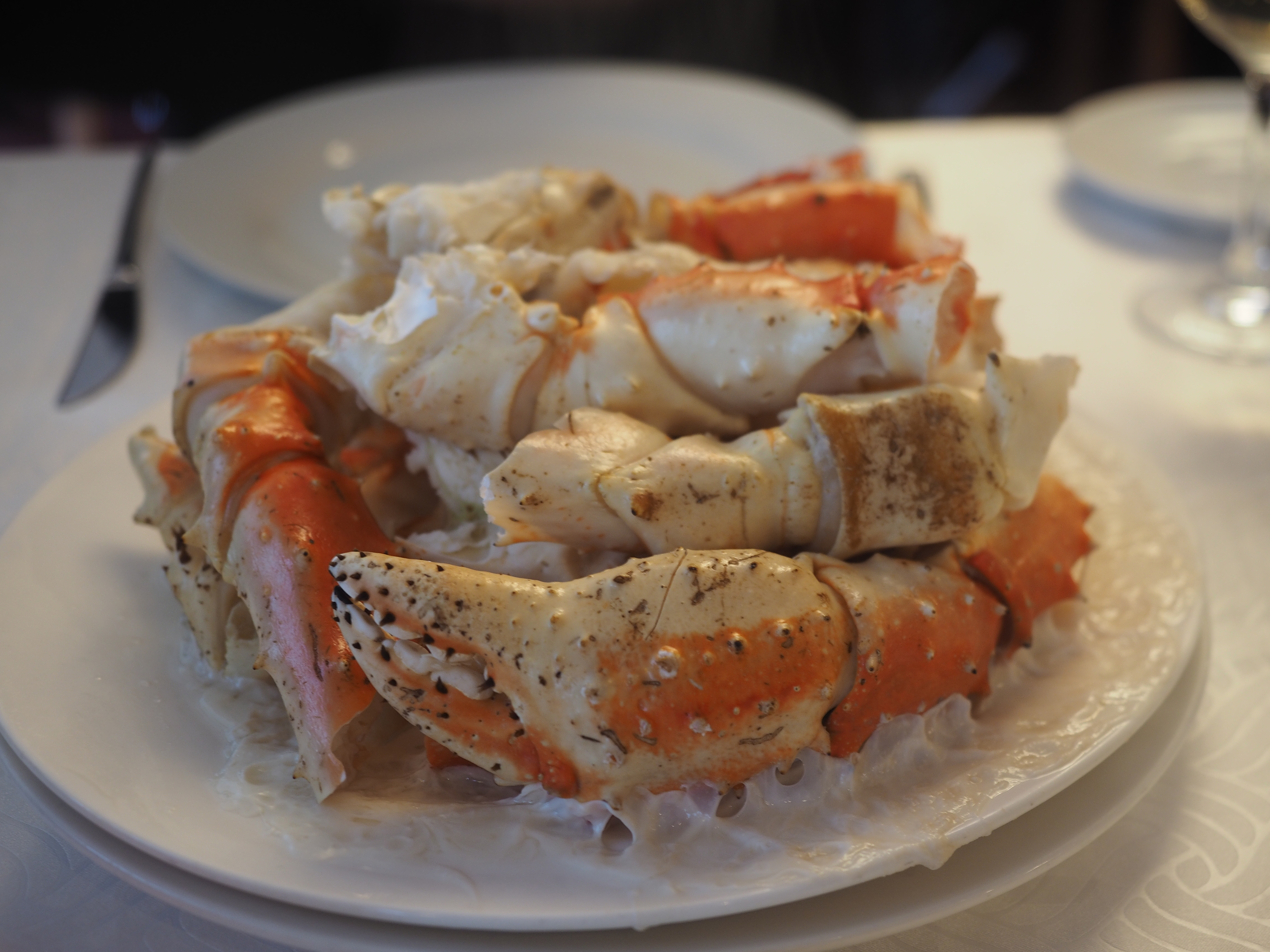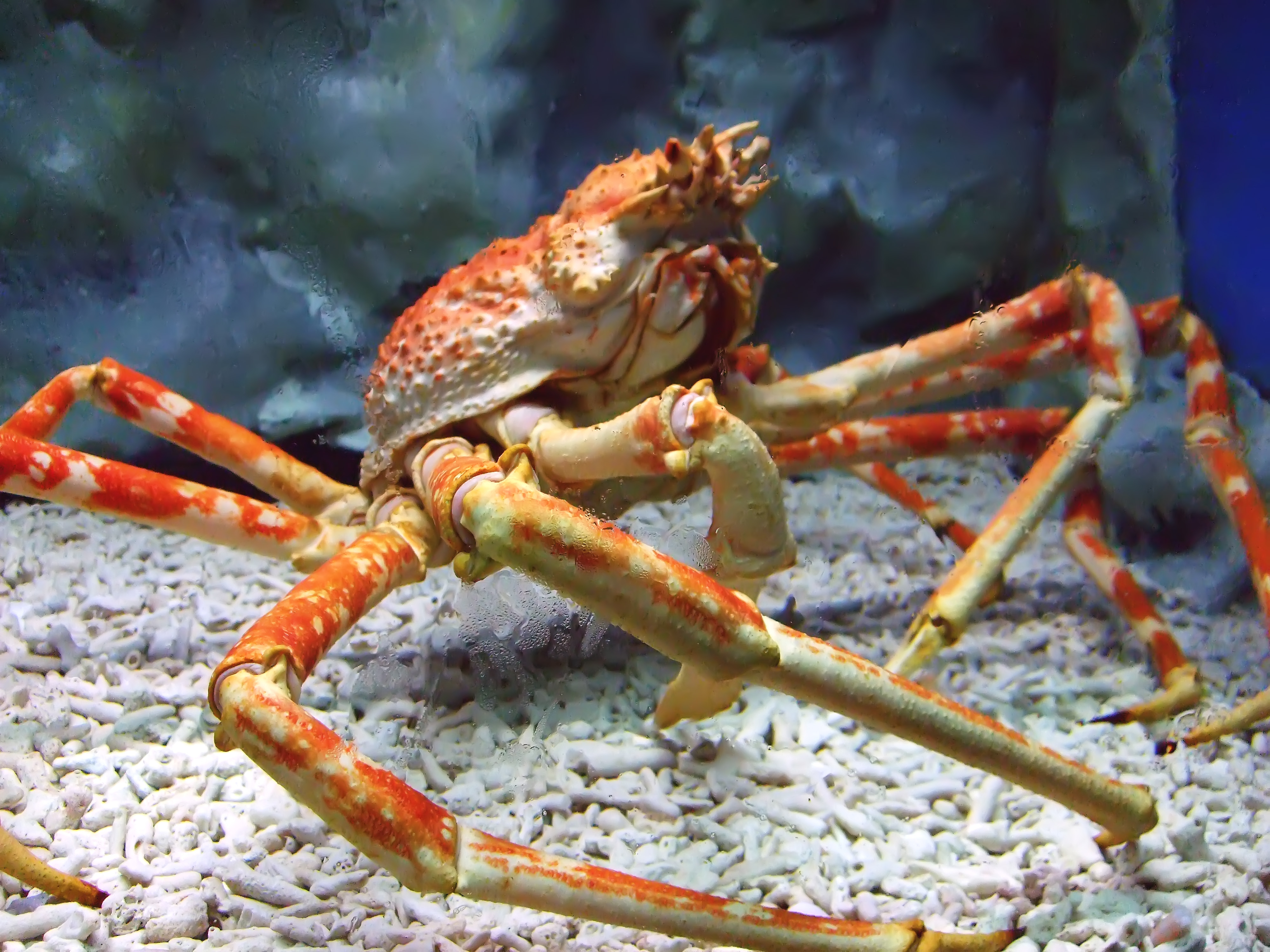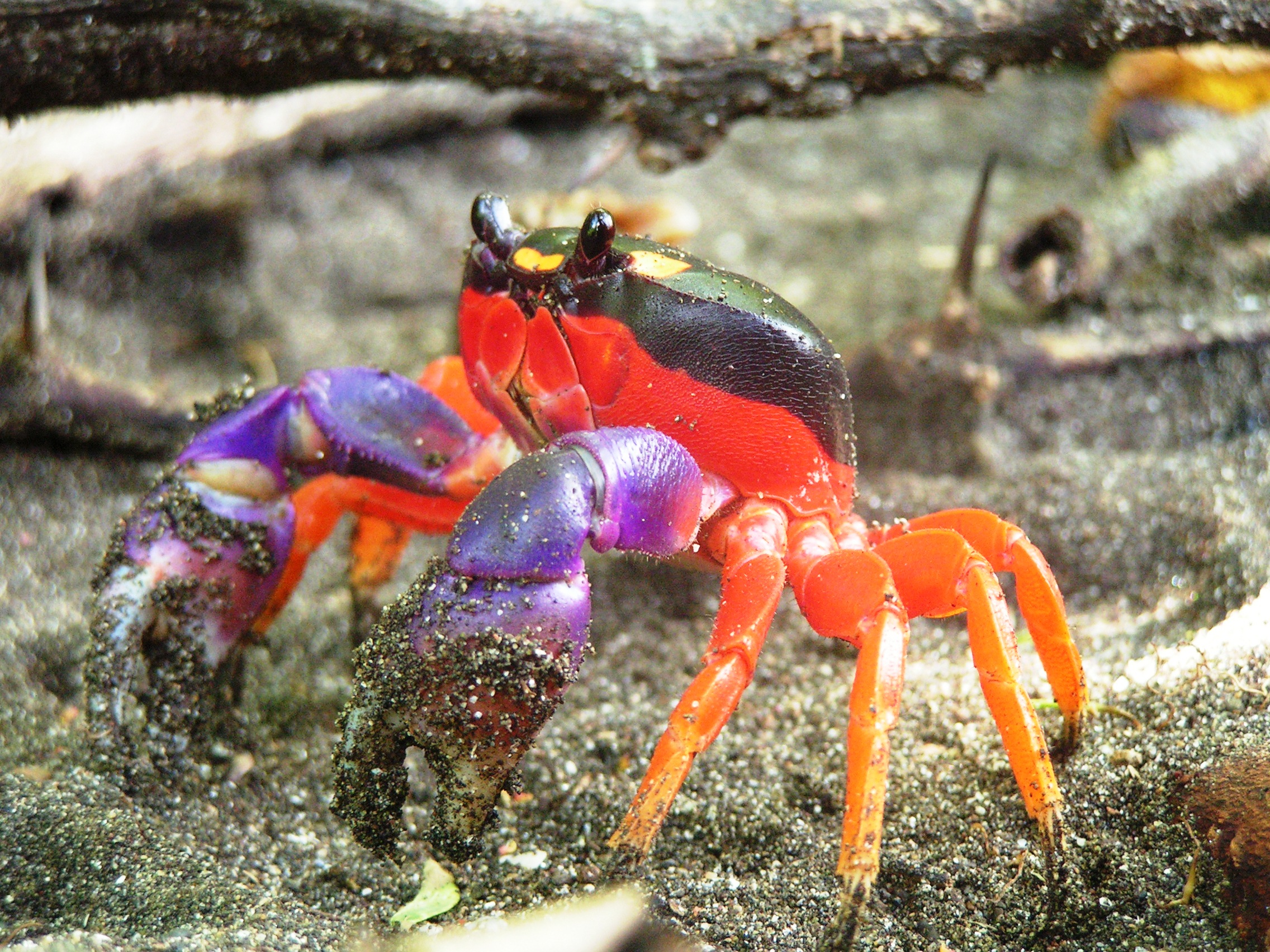|
Crab
Crabs are decapod crustaceans of the infraorder Brachyura, which typically have a very short projecting "tail" (abdomen) ( el, βραχύς , translit=brachys = short, / = tail), usually hidden entirely under the thorax. They live in all the world's oceans, in freshwater, and on land, are generally covered with a thick exoskeleton, and have a single pair of pincers. They first appeared during the Jurassic Period. Description Crabs are generally covered with a thick exoskeleton, composed primarily of highly mineralized chitin, and armed with a pair of chelae (claws). Crabs vary in size from the pea crab, a few millimeters wide, to the Japanese spider crab, with a leg span up to . Several other groups of crustaceans with similar appearances – such as king crabs and porcelain crabs – are not true crabs, but have evolved features similar to true crabs through a process known as carcinisation. Environment Crabs are found in all of the world's oceans, as well as in ... [...More Info...] [...Related Items...] OR: [Wikipedia] [Google] [Baidu] |
King Crab
King crabs are a taxon of decapod crustaceans chiefly found in cold seas. Because of their large size and the taste of their meat, many species are widely caught and sold as food, the most common being the red king crab (''Paralithodes camtschaticus''). King crabs are generally thought to be derived from hermit crab-like ancestors within the Paguridae, which may explain the asymmetry still found in the adult forms. This ancestry is supported by several anatomical peculiarities which are present only in king crabs and hermit crabs. Although some doubt still exists about this hypothesis, king crabs are the most widely quoted example of carcinisation among the Decapoda. The evidence for this explanation comes from the asymmetry of the king crab's abdomen, which is thought to reflect the asymmetry of hermit crabs, which must fit into a spiral shell. Controversial taxon Although formerly classified among the hermit crabs in the superfamily Paguroidea, king crabs are now placed in ... [...More Info...] [...Related Items...] OR: [Wikipedia] [Google] [Baidu] |
Japanese Spider Crab
The Japanese spider crab (''Macrocheira kaempferi'') is a species of marine crab that lives in the waters around Japan. It has the largest known leg-span of any arthropod. It goes through three main larval stages along with a prezoeal stage to grow to its great size. The genus ''Macrocheira'' contains multiple species. Two fossil species of this genus have been found, ''M. ginzanensis'' and ''M. yabei'', both from the Miocene of Japan. Its diverse taxonomic history is an important part of what these creatures are and how they evolved to be what they are today. They are sought by crab fisheries, and are considered a delicacy in Japan. Conservation efforts aim to protect these creatures and their population from overfishing. The Japanese spider crab is similar in appearance to the much smaller European spider crab ''(Maja squinado)'', though the latter, while within the same superfamily, belongs to a different family, the Majidae. Description The Japanese spider crab has the ... [...More Info...] [...Related Items...] OR: [Wikipedia] [Google] [Baidu] |
Terrestrial Crab
A number of lineages of crabs have evolved to live predominantly on land. Examples of terrestrial crabs are found in the families Gecarcinidae and Gecarcinucidae, as well as in selected genera from other families, such as '' Sesarma'', although the term "land crab" is often used to mean solely the family Gecarcinidae. Terrestriality and migration No clear distinction is made between "terrestrial", "semiterrestrial", and "aquatic" crabs. Rather, a continuum of terrestriality is displayed among the true crabs, although most land-adapted crabs must still return to water to release their eggs. Some species of terrestrial crabs can be found many kilometres from the sea, but have to complete annual migrations to the sea. For example, following the Indian Ocean monsoon, the Christmas Island red crab (''Gecarcoidea natalis'') migrates ', forming a "living carpet" of crabs. The crabs can travel up to in a day, and up to in total. Only a few land crabs, including certain '' Geosesa ... [...More Info...] [...Related Items...] OR: [Wikipedia] [Google] [Baidu] |
Freshwater Crab
Around 1,300 species of freshwater crabs are distributed throughout the tropics and subtropics, divided among eight families. They show direct development and maternal care of a small number of offspring, in contrast to marine crabs, which release thousands of planktonic larvae. This limits the dispersal abilities of freshwater crabs, so they tend to be endemic to small areas. As a result, a large proportion are threatened with extinction. Systematics More than 1,300 described species of freshwater crabs are known, out of a total of 6,700 species of crabs across all environments. The total number of species of freshwater crabs, including undescribed species, is thought to be up to 65% higher, potentially up to 2,155 species, although most of the additional species are currently unknown to science. They belong to eight families, each with a limited distribution, although various crabs from other families are also able to tolerate freshwater conditions (euryhaline) or are second ... [...More Info...] [...Related Items...] OR: [Wikipedia] [Google] [Baidu] |
Pea Crab
The pea crab, ''Pinnotheres pisum'', is a small crab in the family Pinnotheridae that lives as a parasite in oysters, clams, mussels, and other species of bivalves. Description Pea crabs are small crustaceans about the size of a pea or dime, with a "smooth dorsal surface of the carapace, or upper exoskeleton". The exoskeleton of males is hard and circular and has eyes and antennae extending from their fronts, and the chelipeds are more robust in males than in females, which have more elongated chelipeds. The bodies of the female pea crabs are often translucent and show the inner organs and gonads as yellow and red, with the males being a "more yellowish-grey with patches of brown". Ecology The relationship between the pea crab and its host is one of parasitism, rather than commensalism, since the host may be harmed by the crab's feeding activities. The pea crab relies solely on its host for food, safety, and oxygen. Pea crabs have a variety of hosts, the most important of whic ... [...More Info...] [...Related Items...] OR: [Wikipedia] [Google] [Baidu] |
Gecarcinus Quadratus (Nosara)
''Gecarcinus quadratus'', known as the red land crab, whitespot crab, Halloween crab, moon crab, Halloween moon crab, mouthless crab, or harlequin land crab, is a colourful land crab from the family Gecarcinidae. Distribution ''Gecarcinus quadratus'' is found in mangrove, sand dunes and rainforest along the Pacific coast from Mexico south to Panama. Previously it has also been reported from the Pacific coast of northwestern South America, but in 2014 this population was recognized as a separate species, '' G. nobili''. The taxonomy in relation to the Atlantic '' G. lateralis'' is disputed, with many considering ''G. quadratus'' and ''G. lateralis'' to be conspecific. Description The carapace of ''G. quadratus'' may reach a length of . It has a pair of largely purple claws, red-orange legs, and an almost entirely black carapace with a pair of yellow, orange, or reddish spots behind the eyes, and an additional pair of whitish spots on the central-lower carapace. Behaviour This ... [...More Info...] [...Related Items...] OR: [Wikipedia] [Google] [Baidu] |
Crustacean
Crustaceans (Crustacea, ) form a large, diverse arthropod taxon which includes such animals as decapoda, decapods, ostracoda, seed shrimp, branchiopoda, branchiopods, argulidae, fish lice, krill, remipedes, isopoda, isopods, barnacles, copepods, amphipoda, amphipods and mantis shrimp. The crustacean group can be treated as a subphylum under the clade Mandibulata. It is now well accepted that the Hexapoda, hexapods emerged deep in the Crustacean group, with the completed group referred to as Pancrustacea. Some crustaceans (Remipedia, Cephalocarida, Branchiopoda) are more closely related to insects and the other hexapods than they are to certain other crustaceans. The 67,000 described species range in size from ''Stygotantulus, Stygotantulus stocki'' at , to the Japanese spider crab with a leg span of up to and a mass of . Like other arthropods, crustaceans have an exoskeleton, which they ecdysis, moult to grow. They are distinguished from other groups of arthropods, such as insec ... [...More Info...] [...Related Items...] OR: [Wikipedia] [Google] [Baidu] |
Decapoda
The Decapoda or decapods (literally "ten-footed") are an order of crustaceans within the class Malacostraca, including many familiar groups, such as crabs, lobsters, crayfish, shrimp and prawns. Most decapods are scavengers. The order is estimated to contain nearly 15,000 species in around 2,700 genera, with around 3,300 fossil species. Nearly half of these species are crabs, with the shrimp (about 3,000 species) and Anomura including hermit crabs, porcelain crabs, squat lobsters (about 2500 species) making up the bulk of the remainder. The earliest fossil decapod is the Devonian '' Palaeopalaemon''. Anatomy Decapods can have as many as 38 appendages, arranged in one pair per body segment. As the name Decapoda (from the Greek , ', "ten", and , '' -pod'', "foot") implies, ten of these appendages are considered legs. They are the pereiopods, found on the last five thoracic segments. In many decapods, one pair of these "legs" has enlarged pincers, called chelae, with the leg ... [...More Info...] [...Related Items...] OR: [Wikipedia] [Google] [Baidu] |
Jurassic
The Jurassic ( ) is a geologic period and stratigraphic system that spanned from the end of the Triassic Period million years ago (Mya) to the beginning of the Cretaceous Period, approximately Mya. The Jurassic constitutes the middle period of the Mesozoic Era and is named after the Jura Mountains, where limestone strata from the period were first identified. The start of the Jurassic was marked by the major Triassic–Jurassic extinction event, associated with the eruption of the Central Atlantic Magmatic Province. The beginning of the Toarcian Stage started around 183 million years ago and is marked by an extinction event associated with widespread oceanic anoxia, ocean acidification, and elevated temperatures likely caused by the eruption of the Karoo-Ferrar large igneous provinces. The end of the Jurassic, however, has no clear boundary with the Cretaceous and is the only boundary between geological periods to remain formally undefined. By the beginning of the Juras ... [...More Info...] [...Related Items...] OR: [Wikipedia] [Google] [Baidu] |
Heterotremata
Heterotremata is a clade of crabs, comprising those crabs in which the genital openings are on the sternum in females, but on the legs in males. It comprises 68 families in 28 superfamilies. Evolution Heterotremata is the sister group to Thoracotremata within the clade Eubrachyura, having diverged during the Cretaceous period. Eubrachyura itself is a subset of the larger clade Brachyura, which consists of all "true crabs". A summary of the high-level internal relationships within Brachyura can be shown in the cladogram below: The internal relationships within Heterotremata are less certain, with many of the superfamilies found to be invalid. The proposed cladogram below is from analysis by Tsang ''et al'', 2014: Superfamilies *Aethroidea *Bellioidea *Bythograeoidea *Calappoidea *Cancroidea *Carpilioidea *Cheiragonoidea *Corystoidea *Dairoidea *Dorippoidea *Eriphioidea *Gecarcinucoidea *Goneplacoidea *Hexapodoidea *Leucosioidea *Majoidea *Orithyioidea *Palicoidea *Parth ... [...More Info...] [...Related Items...] OR: [Wikipedia] [Google] [Baidu] |
Dromiacea
Dromiacea is a group of crabs, ranked as a section. It contains 240 extant and nearly 300 extinct species. Dromiacea is the most basal grouping of Brachyura crabs, diverging the earliest in the evolutionary history, around the Late Triassic or Early Jurassic. Below is a cladogram showing Dromiacea's placement within Brachyura: The larvae of Dromiacea resemble those of the Anomura more closely than those of other crabs. This may simply reflect their basal position in the crab phylogeny. The superfamily Eocarcinoidea, containing ''Eocarcinus'' and ''Platykotta'', was previously considered to be a member of the Dromiacea, but has since been transferred to the Anomura. The fossil record of Dromiacea reaches back at least as far as the Jurassic, and, if '' Imocaris'' is indeed a member, into the Carboniferous. Dromiacea primarily consists of two groups of superfamilies - Dromioidea and Homoloidea. See the below cladogram: Recent studies have found that some of the fam ... [...More Info...] [...Related Items...] OR: [Wikipedia] [Google] [Baidu] |
Eubrachyura
Eubrachyura is a group of decapod crustaceans ( ranked as a "section") comprising the more derived crabs. It is divided into two subsections, based on the position of the genital openings in the two sexes. In the Heterotremata, the openings are on the legs in the males, but on the sternum in females, while in the Thoracotremata, the openings are on the sternum in both sexes. This contrasts with the situation in other decapods, in which the genital openings are always on the legs. Heterotremata is the larger of the two groups, containing the species-rich superfamilies Xanthoidea and Pilumnoidea and all the freshwater crabs (Gecarcinucoidea, Potamoidea). The eubrachyura is well known for actively and constantly building its own burrows. The fossil record of the Eubrachyura extends back to the Cretaceous; the supposed Bathonian (Middle Jurassic) representative of the group, '' Hebertides jurassica'', ultimately turned out to be Cenozoic in age. Here is a cladogram A cladog ... [...More Info...] [...Related Items...] OR: [Wikipedia] [Google] [Baidu] |
.jpg)







